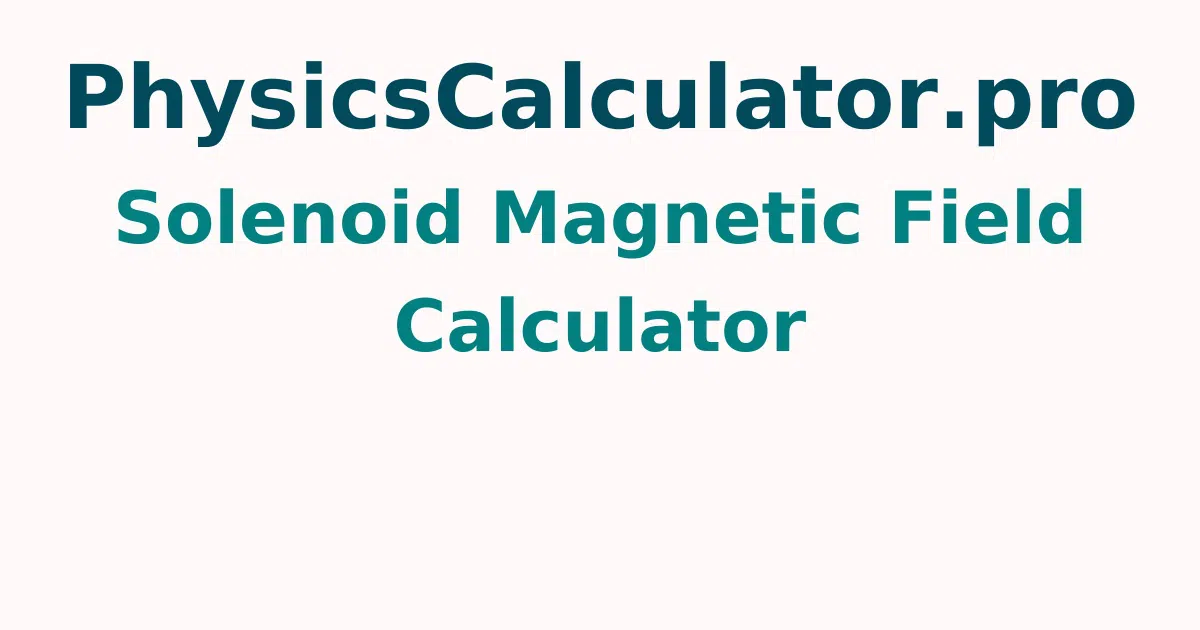Solenoid Magnetic Field Calculator
To determine the magnetic field within a solenoid, use the Solenoid Magnetic Field Calculator tool. Simply enter the current, length, and number of turns into the calculator's input fields and press the calculate button to obtain the magnetic field as quickly as feasible.
Solenoid Magnetic Field Formula
The solenoid is a coil of tightly wound wire that is long and thin. When current flows through a wire, it creates a magnetic field surrounding it. Outside an infinite length solenoid, the magnetic field is zero, whereas, inside the solenoid, the magnetic field is constant. The magnetic field inside a solenoid is calculated using the formula below.
B = μoIN / L
- Where, B = magnetic field of the solenoid
- I = current flowing through a solenoid
- μo = vacuum permeability and its value is 1.26×10-7 Tm/A
- A = cross-sectional area of the solenoid
- N = number of turns
- L = length of the solenoid
How to Determine the Magnetic Field Inside a Solenoid?
Study the complete techniques for calculating the magnetic field within a solenoid without difficulty. Go over the ideas and rules and make sure you follow them.
- Step 1: Calculate the current flowing through the solenoid, as well as the number of turns and length of the solenoid.
- Step 2: Multiply the number of turns by the vacuum permeability constant and current to get the total number of turns.
- Step 3: To assess the magnetic field, divide the product by the solenoid length.
How to Use the Solenoid Magnetic Field Calculator?
The following is the procedure how to use the solenoid magnetic field calculator
- Step 1: Enter the current, length, number of turns in the given input fields of the calculator.
- Step 2: To acquire the result, click the "Calculate the Unknown" button.
- Step 3: Finally, the output field will show the magnetic field easily.
Examples on Calculating Magnetic Field in a Solenoid
Question 1: Determine the magnetic field produced by a solenoid with a length of 90 cm and a coil with 360 turns and a current of 25 A?
Solution:
Given: Number of turns N = 360
Current I = 25 A
Permeability μo = 1.26 × 10^-7 T/m
Length L = 0.9 m
Magnetic field, B = μoIN / L
B = (1.26×10^-7 × 25 × 360) / 0.9
B = 1.26× 10^-3 N/Amps m
The magnetic field generated by the solenoid is 1.26× 10^-3 N/Amps m.
Question 2: The magnetic field of a solenoid with a diameter of 50 cm is 3.9 105 N/Amps m. Determine the current flowing through it if it has 360 turns.
Solution:
Given: No of turns N = 360
Length L = 0.5 m
Magnetic field B = 2.9 × 10^-5 N/Amps m
The magnetic field formula is given by
B = μoIN /L
current I = BL / μoN
I = (2.9×10^-5 x 0.5 )/ (1.26×10^-7 × 360)
I = 319 mA
For more concepts check out physicscalculatorpro.com to get quick answers by using this free tool.
FAQs on Solenoid Magnetic Field
1. What's the connection between the electric and magnetic fields?
A magnetic field is created when an electric charge moves, causing an increase in the electric field in front of it and a decrease in the electric field behind it. A magnetic field is an area around a magnet that produces a magnetic pull.
2. What is an ideal solenoid?
A solenoid is a coil of wire twisted in a helix shape. An ideal solenoid is tightly wound and infinitely long, meaning that the turns are closely spaced and the solenoid is exceedingly long in comparison to its cross-sectional radius. A solenoid's turn is roughly equivalent to a circular loop.
3. What factors influence the magnetic field of a solenoid?
The current and density of turns in a solenoid determine the magnetic field. The magnetic field's energy density is determined by the field's squared strength as well as the magnetic permeability of the substance it occupies.
4. Is the magnetic field affected by the length of the solenoid?
Yes, the magnetic field is affected by the solenoid length. Because the magnetic field is inversely proportional to the coil length, the longer the solenoid, the lower the magnetic field.
